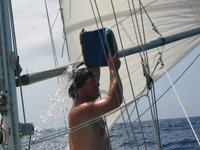Membership has its Privileges . . .
Anchoring for free where we can park our dinghy during shore trips is not often possible in major metropolitan areas. Knowing this, we headed for one of the marinas in a major yachting center east of downtown thinking it'd be easier to find boat chandleries and that we might be able to do some racing to get to know some local sailors. And we were right. We’re in Hebe Haven Yacht Club (not “He be Misbehavin’” from the musical, which popped into my head and cracked me up as I was trying to call them on the VHF radio). Turns out no one monitors the VHF since everyone has cell phones. No wonder no one answered!

So we tied up alongside a fancy dock and walked up to the yacht club, skuzzy as we were from the passage. As we looked around we realized we weren’t as underdressed as we had thought, since most people around the club grounds were dressed casually.

On our way up the dock, we saw more boats than we’ve seen in some time and clear evidence of prosperity. We were dumfounded as we walked by a sizeable haul out facility and racks of runabouts stacked 3 high to maximize the number of boats that can fit into a parking lot.

We saw hoards of sailing dinghies and a sailing education center as we walked up to the club office. Evidently the club has a very active junior program. We checked in with the club office and found that the dues were about $90USD for a month. When they first quoted the fees in Hong Kong dollars we were a little shocked, but dividing by about 8, gives us the price in US dollars and we weren’t as overwhelmed.

The yacht club dues give us full access to the club and all its facilities as members, plus a very inexpensive mooring with a free sampan (dinghy) service, free wifi access from the boat (!), and a luxurious club with more sailing and business magazines that we could hope to read in a month. We could hardly wait to set up the computer for wifi Internet access.

When we finished settling with the office, we got cleaned up. When you’ve been offshore for a couple of weeks, you grow to really appreciate the little things in life, like hot showers with shampoo and conditioner provided. We then had an incredible curry dinner at the club with the most giant prawns I’ve ever seen. We were psyched to see the variety of stout beers, many available on tap at the bar, and note the variety of delectable items on the menu for future meals.

The club is a keen racing club in the area and we've already had a number of opportunities to race. We did a very casual race on a large catamaran which was more like a party boat, with a group of investment bankers. The race took us around a number of islands in the vicinity so it was a great opportunity to do some sightseeing on a gorgeous clear day. At the conclusion of the race, we sailed to a nearby bay for a seafood feast. So civilized. And what a feast it was! We had lobster, giant prawns and fish fixed several ways. Delicious! We even tried snails in a spicy red sauce - a little rubbery but tasty. Then we did a race on monohull keelboats - Garth on one boat (with a cast of thousands and massive quantities of Filipino rum), and me on a 4 person boat (with a couple of Guinness). I got to do a lot; My boat won, and I ended up with a nice t-shirt. Then this past weekend we were invited to race a dinghy regatta with a Japanese sailor on a Laser Stratus, a 2-3 person boat with an asymetrical spinnaker. I raced both days and Garth raced one of them. We won our division and ended up with a couple more t-shirts, a trophy pennant, and a very nice engraved crystal sailboat. Wow what loot! Got to send the heavy one home!




